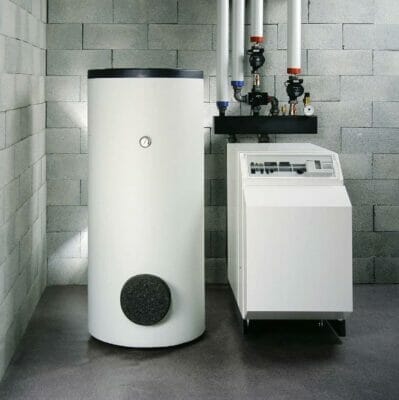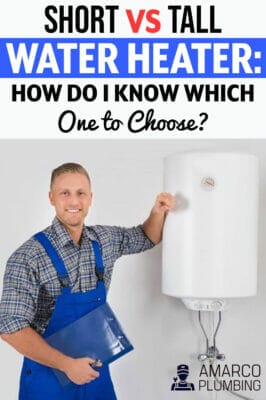Disclaimer: This post may contain affiliate links, meaning we get a small commission if you make a purchase through our links, at no cost to you. For more information, please visit our Disclaimer Page.
Water heating ranks on average the third highest consumption of energy on households and the third most costly. This is only after the heating and cooling and refrigeration, so you can imagine how important it is to know how best to maximize your water heater's efficiency. By doing so, you can end up saving hundreds and eventually thousands of dollars on water bills per year.
One crucial distinction that is important to know is the difference between taller and shorter water heaters. Knowing the size of your water heater lets you know exterior dimensions, obviously, but more importantly, how many gallons you can store at once. Your water heater's height and capacity can impact the cost of your water heater, and determining these numbers can help you save.
Today we'll be helping you in this endeavor by pointing out their characteristics, where they are similar and where they differ, and which one you should choose based on your situation.
The Characteristics of Short and Tall Water Heaters
Let's start by giving a basic description of short and then tall water heaters.
Short water heaters are characterized by their shorter and broader design, leading to their nickname "low boy." They are typically between 30 and 49 inches tall with tanks that usually range between 20 and 26 inches in diameter. This makes them ideal for installation in places such as crawl spaces or tucked away in a less frequented corner.
However, you will still have to compensate for the pipe that connects the heater to the plumbing, typically between 29 and 32 inches. They usually store between 30 and 50 gallons of water but can hold as low as 10 gallons.
Taller water heaters can be exorbitantly different. They can have a height that ranges anywhere between 46 and 60 inches tall and a diameter between 18 and 21 inches wide. They are more cylindrical than the shorter variety, which has a more diverse shape range. As opposed to the "low boy," and because of their taller build, they have the nickname "tall boy."
Because of their height, it is more difficult to find an excellent place to install them. They are typically installed and located in basements or home garages, where there is also space to accommodate their connecting pipe, which is usually more substantial thanks to the larger device overall. These pipes are typically around 40 inches long. Luckily some ingenious plumbers might be able to slant the angle of the pipe to fit a ceiling.

Short Water Heater
The Similarities and Differences in The Characteristics
Of course, as water heaters, they will be quite similar and quite different in some regards. Most of the time, they include the conventional water tank that keeps water inside. Additionally, you'll want to look for auxiliary rooms to keep them in, such as garages, attics, or crawl spaces for the smaller varieties. Ideally, you'll want it to be installed near where the plumbing is easily accessible and where you can easily get fuel to it.
Speaking of, most water heaters can work off of natural gases, propane, and electricity. More modern varieties are built with more sustainable means and store water to be heated via solar energy or heated by solar panels and cells powering them. They are also most commonly installed vertically which allows for faster delivery of the hot water. However, there were some instances where this is impossible, and less efficient means are used for installation.
This is where the similarities end, however, and the differences begin. Of course, the significant differences are in their size, shape, and capacity. Taller water heaters are typically around 16 inches taller and can hold up to 50 more gallons of water. They will also usually require about 10 inches more in height to account for the plumbing.

Tall Water Heater
The Pros and Cons in Comparison - Which Do I Choose?
Here we will make some quick comparisons so that you can make a more informed decision.
Make no mistake, both tall and short water heaters are pretty even in terms of how well they end up serving you and how efficiently they work. The difference is instead in your circumstances and which design is better for you - as well as what you can afford.
Generally, you'll want to follow the rule of "if it ain't broke, don't fix it." You won't be needing a taller water heater unless you do, and you'll know when you do. Otherwise, start planning for a shorter water heater and see if it ticks all the boxes for your requirements.
Typically, a short water heater will do you well for a family or group of three or fewer. If you find your household to be larger than three members, or that you seem to run out of hot water quickly because of showers and baths or the use of a dishwasher and washing machine, then perhaps you can look into getting a taller water heater.
The height of the water heater isn't a true deciding factor, you see. Instead, the size is just used as a naming scheme when the capacity is what we are truly interested in. But there are other considerations to make other than "I'm running out of hot water and need more."
Water heaters can take up a lot of room; that much is discussed under their characteristics. It's no good getting a tall water heater when you don't have the facilities and space to keep it.
Thankfully you'll likely be living in a larger building with the space available if you're already a larger household, but if you are living alone or with a roommate, then you're already pushing it thin by considering a tall water heater. Remember that the more water you have heating at once, the more expensive your bill will be.
The Final Verdict
To answer the question posed before, it's a lot more straightforward once you know what to consider. The answer will almost always be a short water heater unless you are:
- A household larger than three
- Regularly running out of hot water
- Using appliances that consume a lot of water already, such as a dishwasher or washing machine
Don't forget to consider the size and installation requirements of these heaters when considering an upgrade, as it may just not be worth it.

